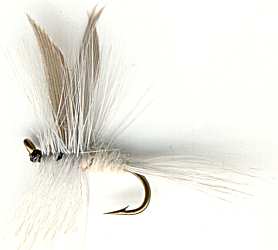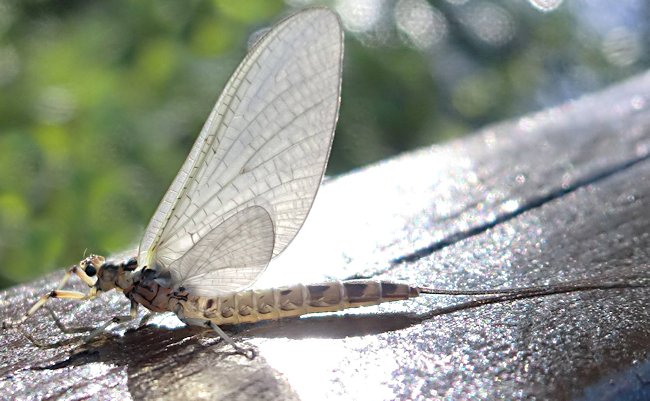The White Miller Dry Fly
ITS MILLER TIME! - The White Miller fly is sometimes just known as the White fly. In the smaller hook sizes is ideal to imitate those tiny white midges.

DRY FLY PATTERNS. Hook size 12 14 16 18 20 24 - $US each
It is designed to represent the adult stage of the mayfly Ephoron leukon that commonly hatches in Eastern and Mid Western USA rivers from mid-July to early-August. The nymph lives in soft, muddy sediments in slow flowing rivers. Eggs are lain in the river where they settle into the sediments for a long incubation period. Once they hatch, the nymphs begin to forage for food in the sediments, using their tusks to root around for food. A Gold Ribbed Hares Ear or a Pheasant Tail Nymph are good choices for imitating the insect at this stage. The nymphs transform into the adult stage in July and August. It has one of the shortest adult stages. The male nymphs swim to the surface of the water and emerge as a light tan dun normally just before dusk. Almost immediately, the dun goes through the second molt to emerge from the water as a white spinner. This is so fast that the cast skin of the dun is often still attached as the mayfly makes its way to the riverside vegetation.

The first hatch of the males is over in about 10 minutes. Then about one half hour later at dusk, the female begins to emerge. The legs of the female are small and she cannot leave the water. The males immediately fly back to the water to fertilize the females. Mating occurs so fast that the females do not emerge from the dun stage; they discharge fertilized eggs and die in a matter of a few minutes. Be prepared for this hatch as you have to fish it early in the hatch, as the trout feed so voraciously at the start that they become full and stop feeding before the hatch is over. The timing of the White Miller hatch can be altered by temperature and water flows, so time of the hatch can fluctuate two to three weeks around the middle of July. The larger White Miller Fly is a nice break for the fly fisherman who has been fishing all the small hatches of summer. When fishing fly pattern's you must remember that you can use the same standard pattern to represent many types of flies found on the river as long as its in the right color and the right size and is presented correctly along with a hatch that the fish have keyed in on.
The Pale Watery Dun (Baetis fuscatus) likes streams and rivers. The spinner is seldom seen in large swarms and often falls to the water earlier in the evening than others. But if the trout are being picky about what they take they often prefer a Pale Watery rather than other spinners. This fly can be used to represent other light coloured mayfly duns and spinners. Treat with floatant and fish on the surface. Leave the fly to drift with the current. Every now and then tug it over a short distance to mimic take-off or give it a twitch to represent the fly being caught in the surface film just before death.
Using the White Millar dry fly as a drowning Moth Fly Pattern;- Between June and September this is the time when large moths can be found flying around the countryside. Some are very silly and fly foolishly down to the water surface where they entrap themselves in the surface film. On days when there are heavy sudden gusts of wind, many get blown onto the water. They flutter around to try and escape this watery peril. Most drown. Hungry trout are on the lookout for this large mouthful. Moths make a substantial meal for any trout and help them put on the pounds, so they can get through the cold winter months. A large hook White Miller dry fly pattern is ideal to imitate the water ermine moth, the white ermine moth, the female buff ermine moth or any other moth with light coloured wings.
Many species of moths natural habitat is close to the water's edge. Some live in the reeds, sedges, flag Iris, and other waterside vegetation. Some types of moths, known as Pyralid, are partially aquatic because their larvae live under the water surface. Once the fly is cast on the floating line. I let it did drift over the area. I suspect trout to be lurking. As I get near to this location. I give the fly a couple of twitches on the line to make the fly imitate the natural moth trying to break free from the water surface. Hopefully this movement will be notice and initiate a strike from down below.
THE WHITE MILLER AND THE SCOTTISH HIGHLANDS
I was fishing for trout on the river Oude in the Scottish highlands. I normally fish the chalk streams of Southern England. There was a lot of surface activity one evening. The trout were feasting on a small white mayfly. It looked like a pale watery dun but I could not be sure. The nearest fly I had in my fly box that matched this hatch was a size 16 White Miller.
With all this surface activity I had to work out where to cast my dry fly. Normally I would cast upstream and let it drift over the feeding zone. As there was so much activity I decided plonk it in the middle. A fish rose the instant the White Miller fly landed. I relaxed a second as normal and then tightened. I missed it. Half a dozen casts and half a dozen rises later that all resulted in misses frustrated me. What was I doing wrong? This was the technique that I successfully used in the south with no problem.
I started to experiment. I soon found out what correct method worked. If I ignored the pause and tightened straight away I was into the fish. I concluded that in the Scottish Highlands, food is not as plentiful as it is down in the chalkstreams of Wiltshire and Hampshire. These little Scottish trout have to move fast to ensure they eat.
CUSTOMER'S COMMENT
I fish the rivers of the Welsh Boarders. Things really take off in May, with Medium Olives and Pale Wateries hatching as well as an important land bred insect, the Black Gnat, appearing in great numbers. Large Hawthorn flies may be present as well. I find a Black Gnat dry fly the most product fly pattern as it covers two of those four listed flies. A Blue Winged Olive and one of your White Miller
dry flies on a small hook covers the rest. - John Langdon


Fly Fishing books

